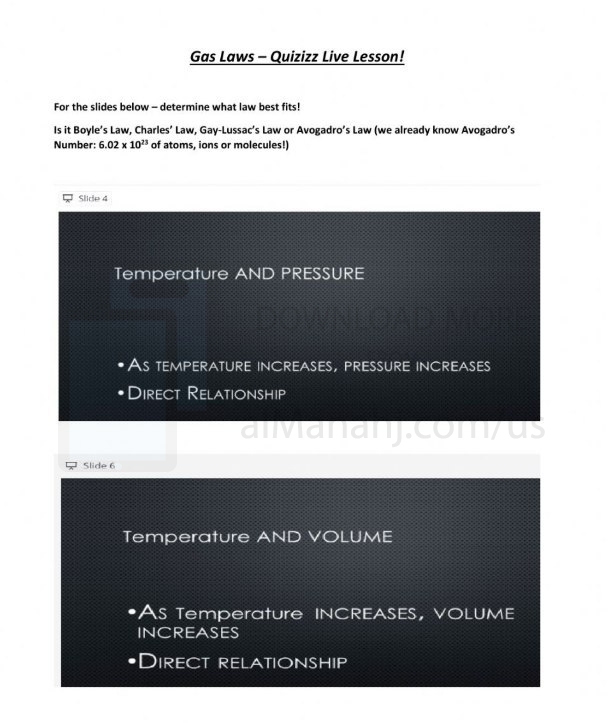| You are here: Almanahj Website ⇒ American curriculum ⇒ 7th Grade ⇒ Chemistry ⇒ Term 1 | ||
|---|---|---|
Worksheet anout chemistry gas laws | ||
|---|---|---|
| Subject: Chemistry | ||
| 7th Grade | ||
| Term 1 | ||
| Year: 2023/2024 | ||
| Size: 298.7KB | ||
| Number of clicks: 131 | ||
| Publish date:November 06, 2023 | ||
| Added by: Eman | ||
| Last download date: 2024-09-10 00:38:22 | ||
| Updated by: Eman9966 on 2023-11-06 06:45:57 | By: theodor N Ross | |
| File info: Gas laws in chemistry are a set of fundamental principles that describe the behavior of gases under different conditions. These laws establish relationships between variables such as pressure, volume, temperature, and the amount of gas. 1. Boyle's Law: Boyle's law states that the pressure of a gas is inversely proportional to its volume, provided the temperature and amount of gas remain constant. Mathematically, it can be expressed as P₁V₁ = P₂V₂, where P₁ and V₁ are the initial pressure and volume, and P₂ and V₂ are the final pressure and volume. 2. Charles's Law: Charles's law states that the volume of a gas is directly proportional to its absolute temperature, assuming the pressure and amount of gas remain constant. Mathematically, it can be expressed as V₁/T₁ = V₂/T₂, where V₁ and T₁ are the initial volume and temperature, and V₂ and T₂ are the final volume and temperature. 3. Gay-Lussac's Law (Pressure Law): Gay-Lussac's law states that the pressure of a gas is directly proportional to its absolute temperature, assuming the volume and amount of gas remain constant. Mathematically, it can be expressed as P₁/T₁ = P₂/T₂, where P₁ and T₁ are the initial pressure and temperature, and P₂ and T₂ are the final pressure and temperature. 4. Combined Gas Law: The combined gas law combines Boyle's, Charles's, and Gay-Lussac's laws into a single equation. It describes the relationship between the pressure, volume, and temperature of a gas when all three variables change. Mathematically, it can be expressed as P₁V₁/T₁ = P₂V₂/T₂, where P₁, V₁, and T₁ are the initial pressure, volume, and temperature, and P₂, V₂, and T₂ are the final pressure, volume, and temperature. 5. Avogadro's Law: Avogadro's law states that equal volumes of gases, under the same conditions of temperature and pressure, contain an equal number of particles. This law implies that the volume of a gas is directly proportional to the amount of gas (measured in moles), assuming the temperature and pressure remain constant. These gas laws provide a theoretical framework for understanding the behavior of gases and can be applied to various real-world scenarios. They are fundamental in fields such as thermodynamics, gas behavior, and the design and operation of gas-related systems, including engines, gas storage, and industrial processes. | ||
| Downloading link Worksheet anout chemistry gas laws |
|---|
|
1699253119.pdf
The file is being prepared for download
|
| File images |
|---|
 |